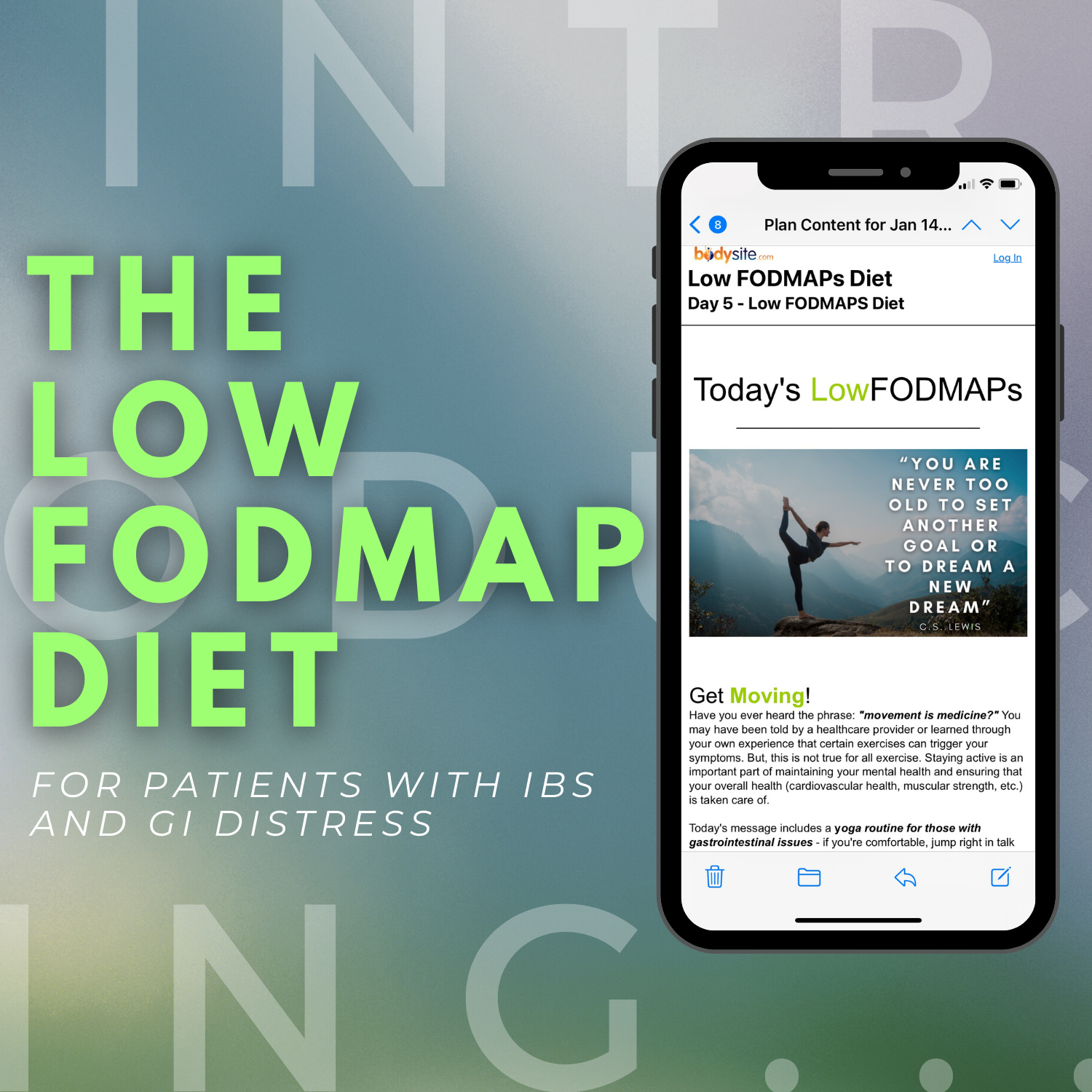Treating Patients with IBS or Other GI Conditions Remotely Using the Low FODMAP Protocol

Exploring and treating a patient’s IBS triggers can be streamlined through combining a virtual wellness portal with the Low FODMAP Diet which can be administered and monitored remotely.
When a patient walks into your office and receives their diagnosis for Irritable Bowel Syndrome (IBS), it can leave them with infinite questions:
- “Can my IBS be cured?”
- “How do you treat IBS?”
- “What’s next?”
As their healthcare provider your first priority is to educate your patients, address their concerns and give them a comprehensive wellness plan moving forward.
The bad news? The root cause of every patient’s IBS varies from person to person and one of the biggest contributors is their diet, another factor that is unique to the individual. The good news: Research has shown that individuals with IBS and other GI conditions can experience improvement in their symptoms through implementation of the Low FODMAP diet.
If you aren’t familiar with what the term FODMAP means and therefore have no clue what Low FODMAP could mean, we’ve got you. FODMAP is an acronym for “Fermentable Oligosaccharides, Disaccharides, Monosaccharides And Polyols.” FODMAP foods are specific foods that cause malabsorption, water retention, fermentation in the small intestine. Therefore, foods that are considered High in FODMAPs can play a major role in your uncomfortable GI symptoms.
Thus, High FODMAP = Higher likelihood of flare up, and Low FODMAP = Less likely to agitate symptoms.
So which foods are considered High in FODMAPs? Here are just a few examples of High FODMAPs in each category:
- Garlic, onions, shallots, beans, and foods that are high in wheat and grain contain Oligosaccharides.
- Apples, watermelon, broccoli and foods that contain artificial sweeteners are made up of Monosaccharides and Polyols.
- Soft cheeses, cow’s milk and creams contain Disaccharides.
Alternatively, foods that are Low FODMAP include:
- Lettuce, kale, spinach, tomato, bell peppers, eggplant and sweet potato to name a few vegetables.
- Strawberries, oranges, pineapple and blueberries are all Low FODMAP fruits.
- Butter, eggs, almonds, walnuts, pecans and minimally processed meat protein are all Low in FODMAPs.
- Even hard cheeses such as cheddar, parmesan and Swiss along with cow’s milk substitutes such as oat milk, or almond milk are considered to be Low FODMAP.
But, the goal of the Low FODMAP diet is NOT to eliminate High FODMAPs forever. In fact, the diet is split up into multiple phases in order to tailor a diet that is right for the individual.
Phase 1: Elimination
Phase 1 is a temporary but strict Low FODMAP diet over the course of several weeks. The goal: to reset the patient’s digestion in order to nearly eliminate their food related symptoms.
Phase 2: Reintroduction
After the patient’s symptoms have been put at bay during Phase 1, they can test a food in each High FODMAP category in order to see which foods and how much of these foods they can tolerate. It’s a three day on and three day off system. For three days the patient tries increasing amounts of a High FODMAP food each day, for example: ⅛ of an apple on day 1, ½ of an apple on day 2, ½ of an apple on day 3, followed by a 3 day break for patients to evaluate the presence or severity of their symptoms.
Phase 3: Maintenance
Once the patient completes their tests they will now have a greater understanding of which foods agitate their symptoms and which foods they can handle. Thus, allowing them to move forward with a diet that works with their body rather than against it.
If you’re thinking, “this sounds like an amazing plan but I wouldn’t know how to begin implementing this in my practice.” Don’t worry, that’s where the BodySite online Low FODMAP program comes in.
BodySite is a remote patient care and monitoring platform that promotes better care and increases practice revenue. Patients automatically receive your guidance each day via email and inside of your web portal, private labeled for your practice and you’re able to see their progress throughout the program. Not only will patients receive breakfast, lunch and dinner Low FODMAP meal suggestions but they’ll also have video resources, everyday to-do’s and motivation to keep them on track.
The best part? Their Low FODMAP program comes with access to a complete lifestyle web portal and app for iPhone and Android. Both you and your patients have access to your own accounts on the platform. Patients can keep a journal, track their progress and follow your program materials anytime, all while you monitor their progress in realtime, every single day.
Click here to schedule a demo of the BodySite platform and to learn more about our Low FODMAP Diet. If you’re not already using BodySite and you’d like to try it out for free, click here to start a 30 day free trial. If you’re already a subscriber to BodySite, this program is already available in your account under Plans > Available Plans & Templates.
To learn more about treating IBS and other GI related issues using the Low FODMAP protocol, watch the video below which highlights the symptoms of patients suffering from these conditions, what FOMDAP means, how the Low FODMAP diet helps, and the features of BodySite that will automate the entire process for providing guidance and care information related to the Low FODMAP program to your patients.
Here is the link to our Low FODMAP Patient Education video so you can easily share it with your patients or clients.

